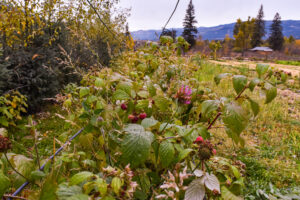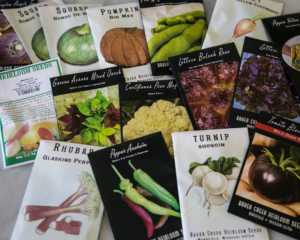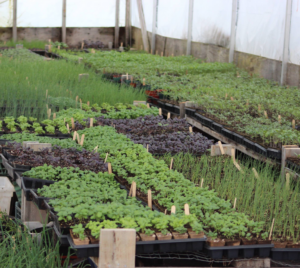4.2 Market Garden
Crop Selection
When choosing your crops:
- What are its soil and water requirements?
- Where are you going to grow it?
- How often does it need to be picked to keep growing well?
- How much labour does it need?
- How will I store it until it sells? How long does it take before it spoils?
- How/where will I sell it? Does the price and volume make it worth it? How much money am I going to make?
Labor-intensive crops (these crops have high nutrient needs, do not store well, need to be harvested continuously to ensure high production):

- Berries (Strawberries, Raspberries, etc)
- Cucumbers, pickling
- Cucumbers, large
- Green beans
- Peas
- Summer squash
- Tomatoes, cherry
- Tomatoes, large
Lower maintenance crops (these crops have lower nutrient needs, store well, can be harvested multiple times or once and stored well):
- Beets
- Brassicas: Broccoli, kale, cauliflower, collard greens, cabbage
- Carrots
- Garlic
- Potatoes
- Winter squash
Market Garden Calendar
This calendar was informed by Dieter Dudy, Thistle Farm (zone 5), Fred Fortier, Uncle Freddy’s Hothouse (zone 5b) and Paula Cranmer-Underhill, Spapium Farm (zone 5).
For a sample crop planning calendar, visit this link.
January:
- Map the previous year in the fields – What worked? What didn’t? Why? If something doesn’t grow or sell well, plant it differently or don’t grow it.
- Create a plan for the coming year of where everything will grow in the field, and plan your crop rotation.
- Create an inventory of all of the seeds from the year(s) before.
- Record the weight of the seeds you applied for the length of the row, this will help with seed ordering for future years.
- With your seed catalogs, write down everything you want to order. Then refer to your existing seed inventory, and update the seed order with what you still need to order.
- Place your seed order by January 31.

Seed order at Thistle Farm - Source your seeds:
- Local seed producers
- West Coast Seeds (BC)
- BC ECO Seed Co-op (BC)
- Pacific Northwest Seeds (Vernon, BC)
- William Dam Seeds (Ontario)
- Baker Creek Seeds (USA) – Heirloom
February:
- Clean and prepare the space where the seeds will be started (e.g. in the greenhouses).
- Order seeding soil, pots, manure, etc.
- Make any repairs to infrastructure (weather permitting)
March:
- As a benchmark, it is about six hours a day of work for 30 days to grow enough seedlings for five acres.
- Start seeding:
- Onions, peppers (March 1)
- Herbs
- Tomatoes (mid-March)
- Get hoophouses ready to start planting in (where you will plant directly in the ground)
- Ways to plant your seeds:
- Soil blocks from Johnny’s Seeds or Lee Valley, 50 blocks per tray
- Peat pots
- In germination box (heat pad, steam) to keep things warmer
- 48-cell trays, then transplanted to larger 3″ pots
- Greenhouses overheat easily, so make sure that soil stays moist

April:
- Plant in hoophouses (summer squash, carrots, beets, greens) once ambient temperature is at least 10C
- In fields, plant potatoes in the fields (mid-April)
- In fields, plant carrots, beets, radishes, kale, spinach, chard (3rd-4th week of April)
May:
- Direct sowing and planting seedlings outside in the fields
- All of the transplants planted in the fields by May 31
- Sell excess transplants
- Monitor your irrigation and fencing lines
June:
- Harvest raspberries and strawberries
- Every two weeks, plant greens, legumes (peas/beans), and some root vegetables
- Weed, general plant maintenance
- Monitor your irrigation and fencing lines
July:
- Harvest raspberries and strawberries
- Every two weeks, plant greens, legumes (peas/beans), and some root vegetables
- As you harvest a crop, plant a new crop – e.g. when harvesting radishes, add compost or soil amendment, then a few days later plant the next crop
- Harvest garlic, plant fall rye in its place, and mulch
- Monitor your irrigation and fencing lines
August:
- Harvest
- Plant any Fall greens or Fall harvest crops, in the field or where you have row covers
- Monitor your irrigation and fencing lines
September:
- Harvest
October:
- Plant garlic
- Clear fields of weeds and crops (do before -10C)
- Cover with cover crop (e.g. fall rye)
November:
- Clear fields of weeds and crops (do before -10C) and mulch to cover the soil
December:
- Paperwork
- Maintenance of machinery
Key Resources
- BC Vegetable Crop Production Guides – many specific crops are listed
- Vegetable Production Guide: Food Safety (Good Agricultural Practices) (PDF)
- Vegetable Production Guide: Grower’s Record (PDF)
- Vegetable Production Guide: Nutrient Management (PDF)
- Vegetable Production Guide: Optimum Storage Conditions for Vegetables (PDF)
- Vegetable Production Guide: Pest Management (PDF, 1.2 MB)
- Tips from The Young Agrarians planning your market garden
Recommended Books
- The Four Season Farm and The Winter Harvest Handbook by Eliot Coleman
- The Market Gardener by Jean-Martin Fortier
- The Lean Farm by Ben Hartman
- Sustainable Market Farming: Intensive Vegetable Production on a Few Acres by Pam Dawling

